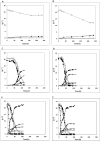Cross-reactions between engineered xylose and galactose pathways in recombinant Saccharomyces cerevisiae
- PMID: 20809958
- PMCID: PMC2940871
- DOI: 10.1186/1754-6834-3-19
Cross-reactions between engineered xylose and galactose pathways in recombinant Saccharomyces cerevisiae
Abstract
Background: Overexpression of the PGM2 gene encoding phosphoglucomutase (Pgm2p) has been shown to improve galactose utilization both under aerobic and under anaerobic conditions. Similarly, xylose utilization has been improved by overexpression of genes encoding xylulokinase (XK), enzymes from the non-oxidative pentose phosphate pathway (non-ox PPP) and deletion of the endogenous aldose reductase GRE3 gene in engineered Saccharomyces cerevisiae strains carrying either fungal or bacterial xylose pathways. In the present study, we investigated how the combination of these traits affect xylose and galactose utilization in the presence or absence of glucose in S. cerevisiae strains engineered with the xylose reductase (XR)-xylitol dehydrogenase (XDH) pathway.
Results: In the absence of PGM2 overexpression, the combined overexpression of XK, the non-ox PPP and deletion of the GRE3 gene significantly delayed aerobic growth on galactose, whereas no difference was observed between the control strain and the xylose-engineered strain when the PGM2 gene was overexpressed. Under anaerobic conditions, the overexpression of the PGM2 gene increased the ethanol yield and the xylose consumption rate in medium containing xylose as the only carbon source. The possibility of Pgm2p acting as a xylose isomerase (XI) could be excluded by measuring the XI activity in both strains. The additional copy of the PGM2 gene also resulted in a shorter fermentation time during the co-consumption of galactose and xylose. However, the effect was lost upon addition of glucose to the growth medium.
Conclusions: PGM2 overexpression was shown to benefit xylose and galactose fermentation, alone and in combination. In contrast, galactose fermentation was impaired in the engineered xylose-utilizing strain harbouring extra copies of the non-ox PPP genes and a deletion of the GRE3 gene, unless PGM2 was overexpressed. These cross-reactions are of particular relevance for the fermentation of mixed sugars from lignocellulosic feedstock.
Figures



Similar articles
-
Kinetic modelling reveals current limitations in the production of ethanol from xylose by recombinant Saccharomyces cerevisiae.Metab Eng. 2011 Sep;13(5):508-17. doi: 10.1016/j.ymben.2011.05.005. Epub 2011 May 27. Metab Eng. 2011. PMID: 21642010
-
Comparison of the xylose reductase-xylitol dehydrogenase and the xylose isomerase pathways for xylose fermentation by recombinant Saccharomyces cerevisiae.Microb Cell Fact. 2007 Feb 5;6:5. doi: 10.1186/1475-2859-6-5. Microb Cell Fact. 2007. PMID: 17280608 Free PMC article.
-
Investigation of limiting metabolic steps in the utilization of xylose by recombinant Saccharomyces cerevisiae using metabolic engineering.Yeast. 2005 Apr 15;22(5):359-68. doi: 10.1002/yea.1216. Yeast. 2005. PMID: 15806613
-
PGM2 overexpression improves anaerobic galactose fermentation in Saccharomyces cerevisiae.Microb Cell Fact. 2010 May 27;9:40. doi: 10.1186/1475-2859-9-40. Microb Cell Fact. 2010. PMID: 20507616 Free PMC article.
-
Development of efficient xylose fermentation in Saccharomyces cerevisiae: xylose isomerase as a key component.Adv Biochem Eng Biotechnol. 2007;108:179-204. doi: 10.1007/10_2007_057. Adv Biochem Eng Biotechnol. 2007. PMID: 17846724 Review.
Cited by
-
Internalization of Heterologous Sugar Transporters by Endogenous α-Arrestins in the Yeast Saccharomyces cerevisiae.Appl Environ Microbiol. 2016 Nov 21;82(24):7074-7085. doi: 10.1128/AEM.02148-16. Print 2016 Dec 15. Appl Environ Microbiol. 2016. PMID: 27694235 Free PMC article.
-
NADH-dependent biosensor in Saccharomyces cerevisiae: principle and validation at the single cell level.AMB Express. 2014 Oct 30;4:81. doi: 10.1186/s13568-014-0081-4. eCollection 2014. AMB Express. 2014. PMID: 25401080 Free PMC article.
-
Erythritol alters phosphotransferase gene expression and inhibits the in vitro growth of Staphylococcus coagulans isolated from canines with pyoderma.Front Vet Sci. 2024 Jan 4;10:1272595. doi: 10.3389/fvets.2023.1272595. eCollection 2023. Front Vet Sci. 2024. PMID: 38239752 Free PMC article.
-
Enhanced glycerol assimilation and lipid production in Rhodotorula toruloides CBS14 upon addition of hemicellulose primarily correlates with early transcription of energy-metabolism-related genes.Biotechnol Biofuels Bioprod. 2023 Mar 10;16(1):42. doi: 10.1186/s13068-023-02294-3. Biotechnol Biofuels Bioprod. 2023. PMID: 36899390 Free PMC article.
-
Leveraging transcription factors to speed cellobiose fermentation by Saccharomyces cerevisiae.Biotechnol Biofuels. 2014 Aug 27;7(1):126. doi: 10.1186/s13068-014-0126-6. eCollection 2014. Biotechnol Biofuels. 2014. PMID: 25435910 Free PMC article.
References
-
- Hayn MSW, Klinger R, Steinmüller H, Sinner M, Esterbauer H. In: Bioconversion of Forest and Agricultural Plant Residues CAB International. Saddler JN, editor. Wallingford, UK; 1993. Basic research and pilot studies on the enzymatic conversion of lignocellulosics; pp. 33–72.
-
- Rudolf A, Karhumaa K, Hahn Hägerdal B. Yeast Biotechnology: Diversity and Applications. Vol. 3. Springer Netherlands; 2009. Ethanol production from traditional and emerging raw materials; pp. 489–513. full_text.
-
- Tantirungkij M, Nakashima N, Seki T, Yoshida T. Construction of xylose-assimilating Saccharomyces cerevisiae. J Fermentation Bioeng 1993. pp. 83–88. - DOI
LinkOut - more resources
Full Text Sources
Other Literature Sources
Molecular Biology Databases
Miscellaneous

